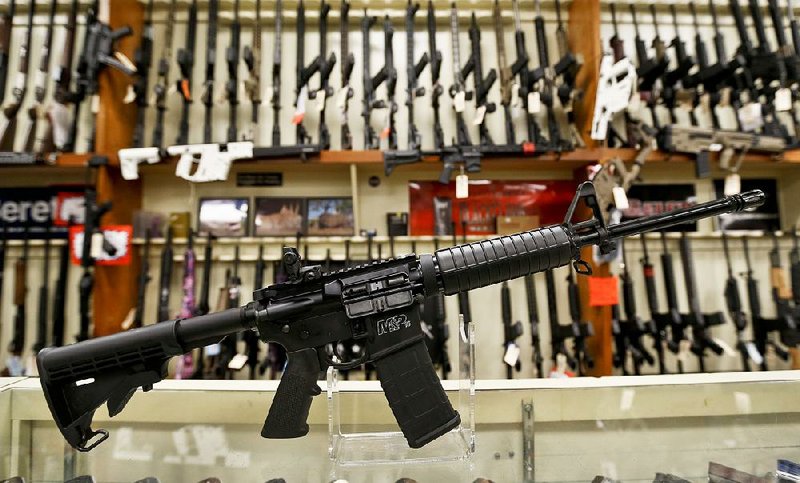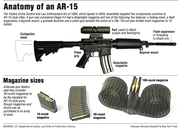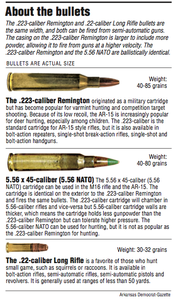Another U.S. mass killing has again thrust a popular class of semi-automatic rifles into a national debate, which continues to rage two weeks after authorities said a gunman used an AR-15-style rifle to kill 17 people at a Florida high school.
Lawmakers and retailers have grappled since with questions over raising the minimum purchasing age — 18 in Arkansas for all rifles and shotguns — as well as restricting the size of ammunition magazines and banning the rifle.
In the ongoing discussion, it’s important to understand what the AR-15 is and what it is not.
So-called AR-15 rifles are popular among competitive shooters and hunters throughout Arkansas because they are light, accurate and fire at a high velocity without strong kicks to the shooter’s shoulder, according to owners and sellers of the guns. Buyers also want them for home defense, dealers said.
However, AR-style rifles are based on a model designed for war. Capable of firing dozens of rounds as quickly as the trigger can be squeezed, the guns have been used in some of the deadliest U.S. mass shootings.
Nikolas Cruz, 19, was charged with 17 counts of premeditated murder, accused of using an AR-15 to kill students, a coach, an athletic director and a teacher Feb. 14 at Marjory Stoneman Douglas High School in Parkland, Fla., authorities have said.
John Dugan of Little Rock, a retired U.S. Air Force colonel and the owner of several firearms, said the Parkland shooting changed his perspective on this type of rifle.
“There’s no way that weapon should be allowed to get into the hands of the average citizen,” Dugan said. “I think [Parkland] was a turning point for me, the sheer amount of killing that that weapon can do in a short amount of time. I feel strongly now that that weapon should not be in the hands of regular citizens.”
[NEW: Sign up for the Arkansas politics and legislative updates email newsletter]
Dugan, who described himself as a supporter of gun rights and a National Rifle Association member, said he cannot understand why a person can buy an AR-15 with the same ease as buying a shotgun. He favors raising the purchasing standards if not an outright ban, he said.
Gun dealers and manufacturers in Arkansas said banning or regulating AR-15-style rifle purchases would do little to prevent mass killings. They said other semi-automatic weapons or even large vehicles can inflict just as much harm. It is more appropriate to make sure people with known psychiatric problems cannot obtain firearms, they said.
Rifle fire killed 1,473 people over the five-year period from 2012-2016, according to the latest available FBI data. That represented about 3.2 percent of 46,445 homicides by gunfire, according to the data. Handguns, for comparison, were used in 67.9 percent of firearms homicides.
But AR-15s have increasingly been a fixture of the nation’s deadliest mass shootings. AR-15 or similar rifles were used in four of the nation’s five deadliest shootings — in Sutherland Springs, Texas; Newtown, Conn.; Orlando, Fla., and Las Vegas — with three of the four coming within the past two years, according to a list published by CNN.com.
Since 2012, AR-15s or similar rifles have been used in 11 mass shootings to kill a combined 214 people, according to a list published by USA Today. Among the dead were worshippers, students, movie watchers and concertgoers.
Dick’s Sporting Goods announced Wednesday that it will no longer sell AR-15s at its Field & Stream outlets; there are none in Arkansas. In 2012, the retailer stopped selling the rifles at its sporting-good stores — there are three in Arkansas — after a gunman killed 20 students and six teachers at Sandy Hook Elementary School in Connecticut.
Walmart Inc., which stopped selling AR-15 guns in 2015, announced Wednesday that it will raise the minimum purchasing age to 21 for all firearms it sells. Federal law bans the sale of handguns to people younger than 21.
GUN HISTORY
AR-15 is a brand name frequently used to describe a class of similar rifles, similar to how Kleenex is a common stand-in for facial tissue varieties. The initials “AR” stand for Armalite Rifle, the gun’s original designer.
Armalite licensed the AR-15 design to Colt’s Manufacturing Co., which produced and sold the rifles to the military as well as the American public.
AR-15s are known as the civilian counterpart to the M16. The M16 was first deployed in battle during the Vietnam conflict and later became the military’s standard-issue rifle.
The primary difference between AR-15s and M16s is the military weapons are built with an option to fire automatically. That means the weapon can discharge bullets in three-round bursts per trigger pull or, in the earliest models, for as long as the trigger is held down, said John Douglas, owner of Wild-man Arms in Bryant.
The civilian version, which is semi-automatic, fires a single bullet each time the trigger is pulled.
Dozens of firearms manufacturers — including Colt, Bushmaster, Ruger and Smith & Wesson — have produced proprietary versions of the rifle under various trademarks since many of the original patents expired in the late 1980s.
Known among the public as AR-15s, they are characterized by light weight, high firing velocity and the ease with which they can be customized.
The National Rifle Association has referred to the AR-15 as “America’s rifle.” It’s unclear how many are in circulation — estimates range from several million to as many as 15 million — or how many people own AR-15s.
“It looks like a military firearm,” said Jeb Burnett, a Little Rock gunsmith and tactical-weapons expert. “It has a pistol grip, black plastic furniture, a flash hider, bayonet lug, and a conspicuous ‘banana clip,’ what people call the box magazine. The U.S. military started using the M16 in 1962, but the civilian version came out in 1959. This isn’t a new gun.
“People stigmatize this rifle strictly based on looks. It’s no more capable than any other firearm.”
PREVIOUS BAN HIT RIFLE’S PARTS
The Violent Crime Control and Law Enforcement Act of 1994, signed by President Bill Clinton, outlawed weapons the law defined as “semiautomatic assault weapons.” The law lapsed in 2004.
For rifles, it essentially targeted five components common to AR-15s. It applied to semi-automatic rifles that had a detachable magazine and at least two of the following five features: a folding stock, a flash suppressor, a bayonet mount, a grenade launcher and a pistol grip beneath the action of a rifle.
The ban targeted the “military style components rather than the rifle itself,” said Douglas, who sells between 50-100 AR-15s per month at Wildman Arms. “Those accessories actually didn’t change the way the gun operated.”
The 1994 act also limited most magazines to 10 cartridges. Douglas and other dealers said they consider the 30-round magazine to be standard for AR-15s. “Drums” capable of holding 100 rounds are sold for less than $200.
The semi-automatic AR-15s can be fashioned with a “bump stock,” which is a modification to the back end of the gun that allows it to mimic an automatic rifle. The stock slides every time the gun is fired, bumping the trigger against a person’s finger so that the shooter does not need to actively pull it.
Authorities recovered multiple bump stocks from the hotel room of the man who killed 58 people at a Las Vegas music festival last year, according to reports. President Donald Trump said this week that he will ban the device through executive action.
One misconception about the gun is that it can be easily converted to automatic fire, said Bill Pool, a gunsmith and owner of Arkansas Gun Traders in Benton.
“To do that, you’ve got to have extra parts that you have to manufacture,” Pool said. “Even the hammers are different. It involves a lot more than just taking a file to the trigger sear. If you could convert an AR-15 into fully automatic, you would have a machine shop capable of making your own gun.”
It is not against federal law to possess an automatic gun, but it is illegal to produce new ones for use outside of the military. Sales of existing automatic guns — Uzis, for example — are highly regulated and expensive. The National Firearms Act, passed more than three decades ago, made it illegal for a private citizen to own a fully automatic weapon produced after 1986.
“Any fully automatic weapon that was not already in the civilian domain could not be put in the civilian domain,” Pool said of the amendment. “That fixed the supply and, my God, the prices went out of sight overnight. I recently saw a full-auto [military machine gun] that went for about $45,000. An M16 runs about $20,000-25,000. Collectors buy those investments and lock them away. They are not out in the public.”
The cost of AR-15s varies widely depending on how they are modified. Versions of the gun range from less than $600 to more than $2,000.
Bump stocks are only one of the myriad modifications people can make to AR-15s.
Flashlights, laser sights and an array of scopes — red-dot sights for close range and zoomed lenses for longer shooting, for example — can be attached to the gun. A gun owner can buy a lighter or heavier trigger. Bayonets and grenade launchers can be mounted to the gun, though explosive grenades cannot be purchased.
DAMAGE DEPENDS ON AMMO
Burnett, vice president of Armtac & The Armory Guns in Roland, said standard AR-15s are not extraordinarily lethal or powerful.
“It shoots a .223-caliber or 5.56 millimeter light rifle cartridge,” Burnett said. “That’s a small bullet. It’s very fast, but it’s not considered very powerful. It’s kind of a pipsqueak compared to what most people use for hunting.”
A standard AR-15 fires .223-caliber bullets, which can inflict a range of damage on impact, depending on whether they are built to expand or shatter into fragments. AR-15s can be configured to fire larger caliber bullets, though that is uncommon, Douglas said.
The physical damage inflicted by a gunshot has nothing to do with the style of rifle from which it is fired, but from the style of bullet used.
Unlike hunting ammunition, full metal jacket bullets do not expand when they strike the target. Expanding hunting bullets, conversely, nearly double their diameter upon impact, causing maximum trauma.
The type of bullets fired in the Parkland shooting has not been disclosed, but Burnett said that full metal jacket ammunition was used in the shootings at Sandy Hook and the 2012 movie theater shooting in Aurora, Colo.
AR-15s are popular for long-range target shooting and for hunting varmints like groundhogs and coyotes. They are also used for deer hunting, particularly by children because the adjustable stock makes it easier for them to hold, and for hunting feral pigs.
That is contrary to another popular misconception that the AR-15 has no sporting application, Burnett said.
“I have listened to Geraldo Rivera and people like that who say they are weapons of war and not sporting weapons,” Burnett said. “That’s just wrong. The AR is one of the single most popular platforms for hunting today.”
For Dugan, the retired Air Force colonel who newly supports banning AR-15s, the ease with which people can access the weapon is disturbing.
“How did we get to a point in this country where a 19-year-old can walk into a gun store with a significant psychiatric background and purchase a weapon that is designed to kill?” he said. “In my opinion, it’s a military-grade weapon.
“I just think something has horribly gone wrong. … I think it’s just time to say, ‘My God, how many more children are we going to see slaughtered?’”
RELATED ARTICLE
http://www.arkansas…">Gun comments by Trump open Republican rift



